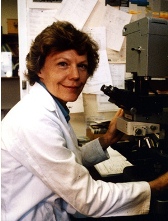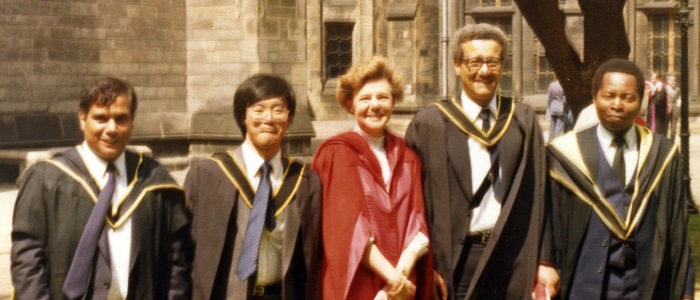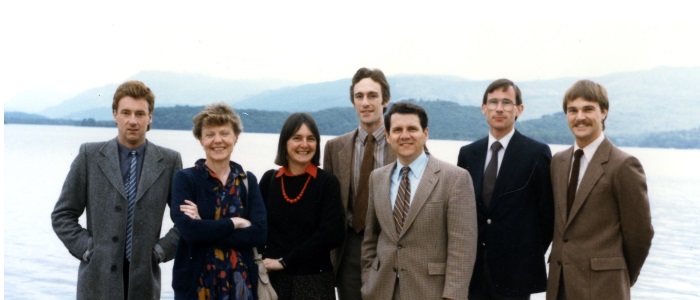Dermatology
University Department of Dermatology
The academic Department of Dermatology was established in 1960 under the leadership of John Alexander Milne who was at that time appointed Reader in Dermatology. He was awarded a personal chair in 1968, and then appointed to the Chair of Dermatology which was established in 1971. The department was situated in the Anderson College Building adjacent to the Western Infirmary and housed laboratories for routine dermatopathology and dermatological research. Medical mycology was also affiliated to dermatology under the leadership of James Gentles, with laboratories on the top floor of the Anderson College.
Clinical facilities were provided in a 20 bedded ward on the ground floor of G block the Western Infirmary with adjacent facilities for biopsy and minor surgery. Outpatient clinics were held in the Church Street outpatient section of the Western. Milne, primarily a pathologist, established a well respected dermatopathology department and ran an annual week-long course on histopathology of the skin which attracted trainee dermatologists from all parts of the UK. He published a well received textbook of dermatopathology. Basic research in the laboratories concentrated on the biochemical abnormalities in acne vulgaris and the molecular biology of psoriasis.
John Milne died in 1977 and was succeeded in the chair by Rona Mackie, the first female full professor in the history of the University of Glasgow.

Mackie’s particular interest was cutaneous malignant melanoma, and in her MD thesis she pioneered the technique of dermatoscopy as a diagnostic aid. This method is now used worldwide. Mackie built up the clinical side of the department while consolidating the research laboratories.
The addition of a “new blood” competitive non clinical senior lectureship (Dr Michael Edward) and a clinical teaching senior lectureship (Dr David Tillman) strengthened the department.
A feature of the clinical department throughout the 1980s was a succession of bright overseas trainees who applied to spend a year or more of their training in the department. Six New Zealanders, two Australians, one Canadian, one South African and one German all spent a year or more in the department carrying out research projects and receiving clinical training.

These bright men and women greatly enhanced the department’s international reputation. Mackie also encouraged UK trainees attached to other NHS dermatology departments in Glasgow- the Royal Infirmary, and Stobhill, Victoria and Southern General hospitals, to participate in weekly clinical and dermatopathological meetings and to carry out research projects in the University laboratories.

Rona Mackie was President of the British Association of Dermatologists in 1994-95. In 1999 she was awarded the Archibald Grey medal, the highest award of the British Association of Dermatologists.
Mackie wrote an undergraduate textbook, Clinical Dermatology, which was well received in the UK and overseas, and ran to five editions. It won the BMA prize for the best undergraduate textbook, a part of the prize being membership of the Society of Authors (read more).
In the late 1980s, the laboratory facilities in the rear section of the Anderson College were inadequate for future development.The dermatology department therefore raised significant sums to enable them to be rehoused in the 4th and 5th floors of the newly built Robertson Building, Western Infirmary, giving the department the best laboratory facilities of any dermatology department in the UK. Dr David Greenhalgh was appointed as a third non clinical senior lecturer in the department in 1992.
Mackie retired in 2000, and the University suspended the chair. Dr Malcolm Hodgins was appointed as a reader and non clinical head of department, and the close link between clinical and scientific activities was lost. Hodgins retired in 2006, and the medical mycology section of the department moved to medical microbiology based in Stobhill Hospital. The laboratory space available to dermatology was reduced to one floor of the Robertson building in 2010, and in 2014 the one remaining non clinical senior lecturer, Dr Greenhalgh, was relocated to the Institute of Cancer Studies in Glasgow Royal Infirmary.
The Scottish Melanoma Group
Mackie, together with colleagues, established the Scottish Melanoma Group in 1979 with the aim of obtaining accurate epidemiological data on melanoma in Scotland. This initial aim was extended to providing a multidisciplinary research and treatment group, involving plastic surgeons (Mr Ian Mcgregor and Mr David Soutar) and vascular surgeons who led the arterial limb perfusion service (Mr Alan Mackay and Mr Dominique Byrne). A steady stream of high impact papers was published throughout the 1990s as a result of these collaborations.
Clinical trials and Collaboration with Department of Medical Genetics
The department played a major role in clinical trials for patients with later stages of melanoma in collaboration with the World Health Organisation Melanoma Group and the European Organisation for the Research and Treatment of Cancer.
As a result of data gathered for the Scottish Melanoma Group, a large cluster of familial melanoma patients was referred to the Dermatology Department which led to research into the molecular genetic basis of melanoma susceptibility. A fruitful collaboration was developed with the University Department of Medical Genetics. The Dermatology Department became one of the two UK based academic centres working within Genomel, a European framework programme -funded collaborative group. A large number of significant high impact papers have been published by this group.
NHS Dermatology Contributions
In Glasgow Royal Infirmary in the 1960s and 1970s, Dr Alan Lyell worked with Dr (later Professor) Sir John Arbuthnott to follow up Lyell’s description of Toxic Epidermal Necrolysis (Lyell’s Disease) with studies on the implicated staphylococcal toxins. Postgraduate clinical training also took place at the Royal Infirmary, and from the mid-1990s throughout the West of Scotland. NHS consultants conducting research of international significance were recognised by the award of Honorary Professorships. These were Colin Munro (2002) in South Glasgow for work on molecular mechanisms of genodermatoses, and David Burden (2010) in the Western Infirmary for genetic and therapeutic studies of psoriasis.
In 2006, Glasgow NHS dermatology services were combined into an integrated service unit, and Alan Lyell was able to attend the inauguration of the new Alan Lyell Centre for Dermatology, named in his honour. In 2015, the reorganisation of clinical and teaching services in Glasgow concentrated this dermatological specialist experience in the new Queen Elizabeth University Hospital in Govan, providing a platform for continuing clinical research.
Professor Rona Mackie
Images provided by Professor Mackie

